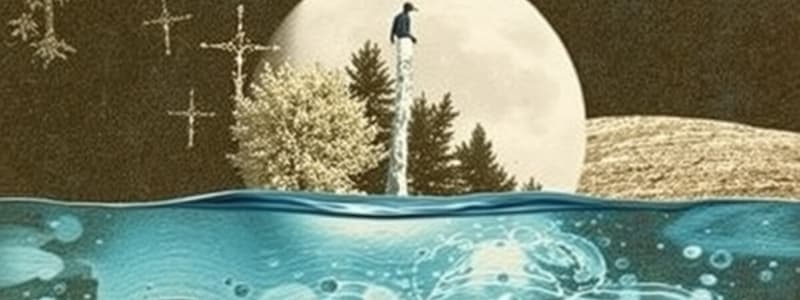Podcast
Questions and Answers
What does HCog represent in the context of the provided content?
What does HCog represent in the context of the provided content?
- The total amount of a compound
- The kinetic energy of molecules
- The equilibrium constant
- The concentration of a solution (correct)
What is the formula indicating about dkal iuity amoubt?
What is the formula indicating about dkal iuity amoubt?
- It denotes a balance in chemical reactions.
- It is derived from the mass and energy relationship.
- It represents a calculated quantity related to concentration. (correct)
- It is an exponential function of time.
In chemical equilibrium, what does the term 'Mg' likely refer to?
In chemical equilibrium, what does the term 'Mg' likely refer to?
- Mass of the reactants
- Molecular gas concentration
- A specific metal ion (correct)
- Molarity of the reactants
What can be inferred about the 'calcate' in the content?
What can be inferred about the 'calcate' in the content?
What is the likely significance of 'dkaliuity cnoustt' in a chemical context?
What is the likely significance of 'dkaliuity cnoustt' in a chemical context?
Flashcards
Cognitive Load Capacity
Cognitive Load Capacity
The ability of a cognitive system to calculate the amount of cognitive load.
Cognitive Load
Cognitive Load
The amount of cognitive load imposed by a particular task or activity.
Intrinsic Cognitive Load
Intrinsic Cognitive Load
The cognitive load imposed by the intrinsic complexity of the task itself.
Extrinsic Cognitive Load
Extrinsic Cognitive Load
Signup and view all the flashcards
Germane Cognitive Load
Germane Cognitive Load
Signup and view all the flashcards
Study Notes
Introduction to Water Technology
- Water is essential for life on Earth
- Water is a solvent and medium for biological reactions
- Ancient civilizations developed near rivers
- Earth's surface is 71% water
Natural Sources of Water
- Surface water: Rainwater, rivers, seas and lakes
- Groundwater: Underground water sources
- Springs
- Wells
- Aquifers
Impurities in Water
- Suspended impurities: Clay, iron hydroxides and organic material, can be seen
- Colloidal impurities: Size between 10 and 1000 Angstroms and are distributed evenly.
- Dissolved impurities: Gases like oxygen, carbon dioxide, and nitrogen dissolved in water, dissolved inorganic materials
- Biological impurities: Algae, fungi, and small aquatic animals
Hardness of Water
- Hardness is the characteristic that prevents the formation of lather with soap
- Water containing calcium and magnesium is hard
- Temporary hardness: Caused by carbonate salts of calcium and magnesium and can be removed by boiling
- Permanent hardness: Caused by sulphate and chloride salts of calcium and magnesium and cannot be removed by boiling
Methods for Determining Hardness
- EDTA method: Commonly used, accurate, and efficient
- Soap titration method: Less accurate
- Other methods: O' Hehner's method
Effects of Hard Water in Boilers
- Premature failure
- Scale formation
- Sludge formation
- Priming and foaming
Softening of Water
- Zeolite process: Cation exchange, removing hardness causing cations
- Lime-soda process: Removing calcium and magnesium
- Ion exchange process: Removing all ions
Purification of Water
- Reverse osmosis
- Electrodialysis
Studying That Suits You
Use AI to generate personalized quizzes and flashcards to suit your learning preferences.




